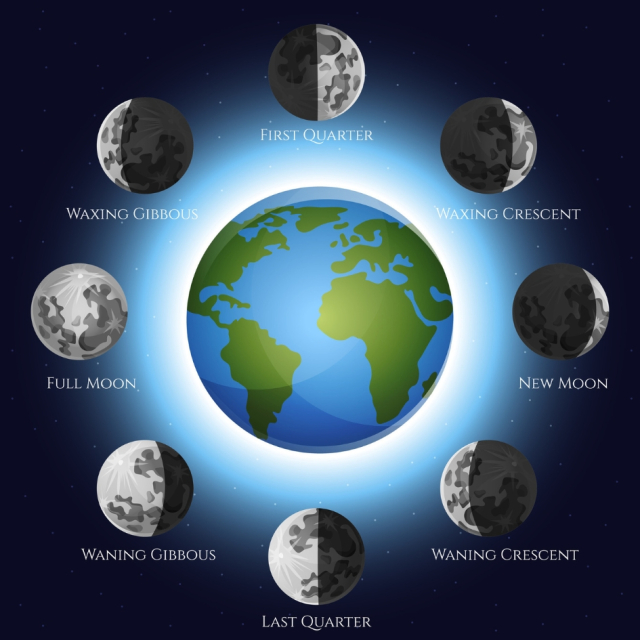The July 2025 lunar calendar is a guide to exploring the phases of the Moon and their impact on our lives. This month features a complete cycle: First Quarter, Full Moon, Last Quarter, and New Moon, each with unique characteristics that have influenced astronomy, agriculture, and cultural traditions throughout history.
Moon phases for July 2025.
First Quarter: July 2, 19:30 UTC
During the First Quarter, the Moon is half illuminated and its visibility increases each night. This phase represents growth and expansion, making it ideal for projects that require momentum. In agriculture, it is a good time to plant crops that grow upwards, such as tomatoes or corn.Full Moon: July 10, 20:37 UTC
This month's Full Moon, traditionally known as the "Stag Moon," is a stunning visual spectacle. The name comes from Native North American peoples, who observed that deer developed their antlers during this period. The full light of the Moon symbolizes plenitude and culmination, and is an optimal time for activities that require clarity and reflection.Last Quarter: July 18, 00:38 UTC
In the Last Quarter, the light of the Moon decreases, representing introspection and preparation for the new lunar cycle. This phase is suitable for concluding tasks, reflecting on achievements and planning future steps.New Moon: July 24, 19:11 UTC
The New Moon marks the beginning of a new cycle. It is a time of total darkness, which symbolizes renewal and the opportunity to set new goals. This phase is also ideal for observing stars and constellations due to the absence of moonlight.First Quarter: July 31, 11:17 UTC
The month concludes with a return to the First Quarter, beginning a new cycle of growth and expansion that will continue into August.
For more details, see sources such as Moon Giant and Calendar-365 .
The impact of lunar phases.
Astronomy and tides.
The influence of the Moon on tides is one of the best-known phenomena. During the Full Moon and New Moon, the alignment between the Sun, Earth and Moon produces spring tides, with a greater difference between high and low tides. In contrast, the First Quarter and Last Quarter generate more moderate tides.
Agriculture and natural cycles.
Since ancient times, farmers have synchronized their activities with the lunar calendar. Waxing phases are ideal for sowing and cultivating, while waning phases are associated with tasks such as pruning and harvesting. These natural rhythms also guide modern gardeners who practice biodynamic agriculture.
Spirituality and cultural traditions.
Many cultures have attached deep meanings to the lunar phases. In contemporary spirituality, the Full Moon is celebrated as a time of wholeness and connection, while the New Moon is associated with new beginnings and setting intentions. In Asian cultures, lunar phases are tied to important festivals, such as the Mid-Autumn Festival in China.
Lunar observation in July 2025.
Tips for observing the Moon.
Observing the phases of the Moon does not require specialized equipment. Still, telescopes and binoculars can enhance the experience by revealing details such as lunar craters and maria. Here are some tips:
- Choose dark places : Get away from light pollution to get a clear view of the sky.
- Plan according to the weather : Weather apps can help identify clear nights.
- Use astronomy apps : Tools like SkySafari and Stellarium offer interactive maps of the sky.
Highlights of July events.
- Full Moon of July 10 : It will be visible from all regions of the world, illuminating the night sky in all its splendor.
- New Moon on July 24 : It will offer a dark sky ideal for stargazing and constellation watching.
For more observing tips, visit Time and Date and NASA Moon Phases .
The July 2025 lunar calendar is not only a useful tool for astronomers, farmers, and casual observers, but it also connects us to the natural cycles that have guided humanity for millennia. From their impact on the tides to their relevance in cultural rituals, the lunar phases continue to remind us of our intrinsic relationship with the cosmos.
Take advantage of this month's lunar phases to observe the sky, reflect on your goals, and connect with nature. These cycles, in constant movement, offer a unique opportunity for contemplation and personal growth.
For up-to-date information, visit Moon Calendar and Lunar Calendar 365 .
